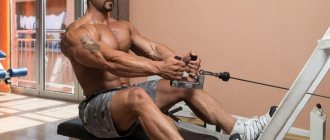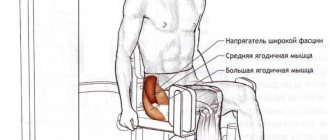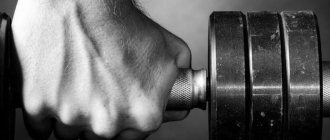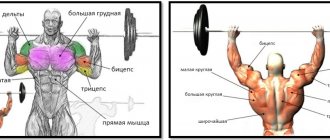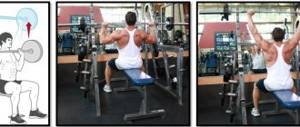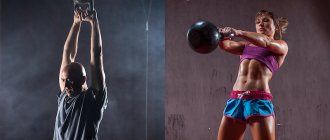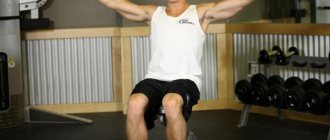October 29, 2015 Admin Home page » Breast
The correct technique for pressing in a chest machine, the secrets of correct execution, the muscles being trained and, of course, an educational video from fitness and bodybuilding experts are described.
Chest press in the simulator to pump up the pectoral muscles
One of the simplest and most effective exercises for the pectoral muscles is the chest press in a machine. Good for beginners. The work includes the chest muscles, front deltoids, triceps of the arms, and a little biceps.
The pectorals are the target muscles in the exercise.
Chest press in the simulator: video
How to do the exercise? Technique
- Set the seat height of the exercise machine to the correct height for you. Sit tightly on the bench. Grab the handles. Raise the weight until your arms are actually straight. This will be the starting position.
- Lower the handles, moving your elbows back as low as possible. As you lower, inhale.
- Press from your chest to the starting position. Under load, when you press, exhale.
- Repeat the range of motion 15 times for 3 sets.
How to do a chest press in a machine? Technique
Application of the exercise
For whom . Any level for girls and men. Recommended for beginners to practice and consolidate the movement - chest press.
When . The machine chest press is best done at the beginning of training the pectoral muscles. After the press, do incline dumbbell flyes and triceps extensions from the upper block.
How many . For beginners, do 3 sets of 15 repetitions. For more experienced athletes to work on weight - 4 x 10 times.
Advice! If you come to the gym to pump your chest, and your favorite horizontal bench for barbell press is occupied. The machine chest press is a great alternative to the basic barbell press.
Exercise options
- Basic and basic. A medium grip or when the seat height is so that the arms are at the level of the middle of the pectoral muscles. Then the load is precisely distributed over the pectoralis major muscle.
- An option for greater development of the upper pectoral muscles. Overhand grip or when the seat height is so that the hands are at shoulder level.
- Alternate chest press in the simulator. For uniform training and targeted concentration on the muscles. Use this version of the exercise.
There are block and lever chest press machines. There is not much difference in the range of motion and the development of muscle groups. Use what you have in the gym.
Chest press. Block and lever trainers
Recommendations for execution technique
- Often, exercise machines have an additional lever for the legs. To help move the handles to a comfortable starting position. Use it by pressing with your feet. If there is no lever. For help, you can turn to your partner in the gym. Ask him to throw the heavy weight into the starting position for the press.
- Perform a movement that is comfortable for your shoulder joints. If flexibility is good, lower the levers of the machine low; if flexibility is not enough, work in the upper range of motion.
- You can choose the load in the exercise depending on the purpose of working out muscle groups. When you spread your elbows to the sides, perpendicular to the body, the pectoral muscles work more. When the elbows are brought together and are closer to the body, the triceps muscles of the arms are more involved in the work.
- An exercise similar to a horizontal barbell press. Good for beginners. Since the movements in the simulator are predetermined and do not need to be coordinated. Unlike horizontal bench presses with barbells or dumbbells.
Common mistakes
- Lifting your back off the backrest and moving your shoulders forward. Keep your back close to the backrest and your shoulders level with the shoulder girdle. Concentrate on your chest muscles.
- Full arm extension. Always keep your arms slightly bent in the final position. This way you will protect your joints from premature wear and aging.
- Incorrect breathing. Under load, when you press up, exhale. When you lower it, inhale.
- Jerks and fast movements. Make clear movements. Try to do lowering slower than lifting.
Did you like the article? Subscribe to us on social networks and be the first to know about new products!
Shoulder training program
A good shoulder workout should work all three deltoids and focus on heavy weights.
Like any muscle, the shoulders can benefit from high rep work, but for best results, focus on heavier weights, but perform the exercises very carefully and securely.
The shoulder exercise program is designed for 8 weeks, one workout every 5-7 days, preceded by a mandatory warm-up.
- Standing barbell press or seated/standing military press: 3 sets of 4–6 reps at 80–85% of maximum effort.
- Barbell Chin Row – 3 sets of 4-6 reps at 75-80% of max effort or 6-8 reps for advanced.
- Dumbbell flyes – 3 sets of 8–10 repetitions at an effort of 70–75% of the maximum.
Rest 3 minutes before each set of 4-6 reps, 2 minutes before sets of 6-8 reps, and 1 minute between sets of 8-10 reps. Adequate rest will allow the muscles to return to normal and do their best in each set.
Shoulder training for girls is at beginner level. There are two main mistakes that most beginners make:
- focus on inappropriate exercises;
- perform too many repetitions.
Focus on lifting heavy weights during your shoulder workout. The harder the exercises are, the fewer repetitions you can do. Focus on exercises that allow for safe progressive overload.
Increasing load over time is the number one rule when building muscle mass naturally.
Make sure you are consuming enough calories through food. Most people know that a high-protein diet is necessary to maximize muscle growth, but they forget that growth will not occur if the daily number of calories is not enough to gain weight.
Shoulder muscle training can be conveniently combined with exercises for the chest (for girls and men) and triceps. You can do a split on the upper body and combine the work of the muscles of the shoulders, arms, back and chest. In this case, pay attention to basic exercises that engage the anterior deltoid to avoid overtraining.
Seated chest press
Are you tired of the usual bench press or dumbbell bench press? There is a solution! The chest press in a machine in a vertical position is an excellent analogue of presses performed while lying on a bench. The exercise perfectly works the pectoral muscles, this exercise allows you to perform presses at different angles. Additionally, the anterior deltoids and triceps are worked out
Chest press in the technique simulator
- We set the weight we need for the block press
- We sit on the seat
- We take the handles with a comfortable grip, bring the shoulder blades together, elbows apart
- I exhale, push the weight away from myself until my arms are fully straightened
- With straight arms, muscles are statically tense
- As you inhale, slowly return the handles to their original position.
- We do repeated exercises in the approach
There are 2 types of simulators: block and lever
Important features when performing the exercise
- It is extremely important to hold your breath while returning the handles to their original position.
- Pressing your feet into the pores will help you overcome stronger loads and working weights
- In the initial sitting position, your elbows should not go behind your back.
- Under no circumstances is it recommended to lift your back or buttocks off the bench while performing the exercise, especially when working with heavy weights.
- Most often, the seated press in a block or lever machine is used at the end of a workout to fully work out the pectoral muscle group after bench presses with barbells or dumbbells.
Pros of doing the exercise:
- You can perform exercises without a trainer or partner, because... in case of failure, as in the case of a barbell, the weight will not press down, the exercise is less traumatic.
- Can be performed by beginners, no special technique or high level of training is required
- The exercise is used for rehabilitation, for example when an athlete is recovering from injuries
- This exercise can be called completely shaping the shape of the breast, because... The middle, upper and lower parts of the chest are fully worked out
- The exercise machine can be adjusted in height to work out a separate part of the chest
Disadvantages of doing the exercise:
The exercise is not popular, it is used exclusively in bodybuilding as an alternative to the bench press
Seated press variations in machines from hammer to smith - technique and combination
The material was prepared by the site team with the support of our experts: athletes, coaches and nutrition specialists. Our team >>
- Reading time: 5 min.
- Which exercise machine should I use?
- Seated press machine
- Hummer Seated Press
- Seated press and Smith machine
- Seated Angle Press
- Seated Vertical Press
- How to best combine exercises
The bench press is a universal exercise that can be used to pump up the upper and middle part of the chest, shoulders, and triceps. On the one hand, this is an imitation of a bench press, on the other hand, a barbell press at different angles and even a seated dumbbell press. And all this is possible thanks to the variety of seated press machines (from the Hammer to the Smith).
Bench press
Description of the bench press exercise. On what simulators it can be performed, what is the difference and the technique of correct execution.
The chest press can be performed on several machines: various benches, a chest press machine, and a Smith machine. Therefore, when looking through the catalog of simulators, take a closer look at them.
What does the chest press do?
The chest press is one of the most popular exercises among athletes. There is often a long line of people wanting to work out at the machines where this exercise is performed. The secret of such popularity is that the chest press is one of the most effective exercises for the chest muscles. This exercise has many tricks, and what kind of grip and what machine the press is used on depends on which particular muscle bundles and sections will be worked.
Bench press
One of the most effective bench presses is the incline barbell press. The press here is the main exercise for gaining muscle mass in the pectoral muscles. At the same time, it involves several joints and is aimed mainly at working the upper part of the pectoral muscle. In addition, secondary muscles, such as triceps and anterior deltoids, also contract.
It is important to remember a small axiom here: greater bench angle = less triceps work; greater bench angle = more work of the front deltoids. One simple conclusion can be drawn from this: the inclination of the bench should be 25 - 30 degrees.
As for the correct execution of the exercise, it is important to place your feet firmly on the floor and press your back against the back of the machine, but you should not allow your back to sag, this way you will relieve the load on your chest muscles. The grip width should be medium - not too narrow and not too wide. The arms in the upper position should not be fully extended, but remain slightly bent. In the lower position, the bar freezes 1 - 2 centimeters from the chest. We exhale with effort, inhale when we press up.
The barbell bench press on a horizontal bench is also no less popular. It is used to pump up the muscles of the chest, triceps and anterior deltoids. The main load falls on the chest muscles, namely, on its lower part. The technique is the same as what you would use for an incline press.
There are also two more techniques for performing this exercise: in the first, you place your feet on a bench in order to completely remove the arch, and the second, when you specifically bend in the lower back.
Seated chest press
It is recommended to do this exercise as a “finisher” at the end of the workout. Also suitable as an alternative to the standing press for those with back problems. It works the front deltoids, but also works the middle deltoids and triceps.
The chest press in the machine imitates a basic exercise, but is not one; you press up two racks loaded with weights - pancakes.
The exercise technique is quite simple. The shoulders should not be leaned forward; they should remain pressed to the back surface. The back is completely pressed against the backrest, a slight deflection is allowed, the legs are firmly on the floor. When your arms press up, at the highest point it is better to straighten your arms, at the lower point it is better to lower them quite low, while avoiding pain in the shoulder joint. There is no need to linger in the lower position; immediately return to the top.
Smith machine press
This exercise resembles a barbell bench press. The difference is that the Smith machine has racks on which the bar moves, which means that training on it is much safer than on a regular bench. This feature is useful for beginners.
In addition, unlike a conventional bench, in a Smith machine the bar moves along a vertical path. Therefore, the load is versatile, which has a positive effect on muscle growth. The main muscle groups involved are the chest and shoulders. Over time, accustomed athletes switch to bench presses on a regular bench, but it’s better to start with the Smith machine.
Execution technique: lie on a bench, fix the bar at such a height that you can reach it with straight arms, the grip should be slightly wider than your shoulders. Lower the bar as you inhale and raise it as you exhale. At the top point you need to pause for a couple of seconds.
Shoulder press in the machine. What, why and why?
When it comes to the gym, women, for the most part, are big fighters. They can't shake the feeling that doing free weight exercises like the seated dumbbell press will develop their shoulders to XL size. That's why many ladies pay more attention to exercise equipment... And they do it right. At first, they are the ideal option for strengthening the whole body and a guarantee of mastering the correct technique for performing the movement. Today we will look at one of them - the shoulder press in the simulator.
Note: For better assimilation of the material, all further narration will be divided into subchapters.
Muscle atlas
The exercise belongs to the class of conditionally basic and is aimed at working the shoulders.
The muscle ensemble includes the following units:
- targeted – anterior delta;
- synergists - middle delta, supraspinatus, pectoralis major (clavicular head), triceps, trapezius (middle/bottom), serratus anterior;
- dynamic stabilizers – biceps, triceps (long head);
- stabilizers - trapezius (top), levator scapula.
A complete muscle atlas looks like this:
Advantages
By performing the shoulder press exercise in a machine, you can expect to receive the following benefits:
- increase in muscle mass of the deltas (subject to certain conditions);
- development of the strength of delta bundles;
- strengthening the upper shoulder girdle;
- formation of symmetrical shoulders;
- improved results in the bench press;
- reducing the risk of osteoporosis by increasing bone mineral density;
- Possibility to perform in case of problems with the shoulder joint.
Execution technique
The shoulder press in the simulator is an exercise of entry-level complexity. The step-by-step execution technique is as follows:
Step #0.
Go to the machine and set the working weight. Sit in a “chair”, spread your legs to the sides, place your feet firmly on the floor, and grab the handles of the exercise machine with your hands. Statically tighten your abs, direct your gaze forward. This is your starting position.
Step #1.
Inhale and as you exhale, straighten your elbow joint and press your arms up. At the top point of the trajectory, hold for 1-2 counts and slowly return your hands to the IP position. Repeat the specified number of times.
In picture form, all this disgrace looks like this:
In addition to the standard version of the shoulder press in the simulator, there are several variations of the exercise:
- neutral grip bench press;
- bench press while facing the bench.
Secrets and subtleties
To get the most out of the exercise, follow these guidelines:
- use a grip slightly wider than shoulder width;
- when taking the handles of the simulator in your hands, adjust the height of the seat until your hands are positioned just above shoulder level;
- slowly and controlledly lower the weight down and powerfully, explosively lift it up;
- use full range of motion;
- do not fully extend the elbow joint at the top point;
- throughout the entire movement, keep your head, back and buttocks in constant contact with the “chair”, and your legs motionless on the floor;
- do not lower the weight/handles of the machine too low, below shoulder level;
- breathing technique: exhale - when squeezing the frame upward, inhale - when returning to the PI;
- numerical training parameters: number of approaches/repetitions – 3x10-12.
We're done with the theoretical side, now let's look at some practical points.
Is the machine shoulder press a good exercise for deltoids?
Electrical activity data (Exercise Physiology Laboratory, USA 2015 ) for shoulder exercises (EMG for the anterior deltoid) show the following:
- seated dumbbell press – 83;
- seated bench press - 81;
- seated dumbbell raises – 75;
- standing raises with dumbbells – 72.
Thus, the seated shoulder press is a very effective exercise for developing the anterior and middle (to a lesser extent) deltoids.
How to pump up a girl's shoulders using exercise machines?
Decorating hangers is exactly what the girls want for this muscle group. By “design” we mean their chiseled silhouette and relief. Here is a PT for solving this problem:
- duration: 10 weeks;
- number of training sessions per week: 2 , Monday/Friday;
- exercises: superset: seated head press in a Smith machine + shoulder press in a neutral grip machine; raising arms to the sides while sitting in a machine with rollers + reverse butterfly in a machine;
- number of sets/repetitions: superset No. 1/No. 2: 3x8/3x16.
Use this training program and you are guaranteed chiseled shoulders.
Technique for performing a chest press in a machine
What can you do, but arm presses for the upper body are like squats for the lower body. Exercises with a lying barbell are most often aimed at working the outer area of the pectoral muscles. Specially designed machines should address this slight imbalance. They shift the point of application of effort slightly to unfinished areas, namely to the inner and middle parts.
Anatomy of the Seated Chest Press exercise:
How to properly perform a chest press in a machine
- Don't be surprised that you can bench press less weight in a machine than with a barbell. The muscles here work differently and get tired faster. Ideally, you will choose a weight so that you can do about 10 repetitions.
- Sit down and adjust the seat so that the handles are approximately chest level. If you sit deeply, shift the emphasis to the upper part of the chest; if, on the contrary, you sit high, then to the bottom. You need to sit with your back and head pressed tightly against the backrest. Spread your feet wider and rest them on the floor. The bend angle at the knees should be straight. Do not put your feet far forward and do not tuck them under you.
- Once the weight is set and you are seated correctly, take the handles and inhale and press them forward. Exhale only at the very end, when you have already passed the most difficult point of the movement. You only need to inhale again when you return the handles to their original position.
- Pause briefly when your arms are straight and return to the beginning.
- The stop will be when the fists are at chest level. This will allow you to stretch your pectoral muscles as much as possible and avoid overstraining your shoulder joints.
- Immediately start pressing the chest again in the machine, do not stop.
Tips for implementation
- Always try to stretch your muscles as much as possible when performing chest presses on the machine. Don't do short (incomplete) reps at the beginning. It’s better to do such “finishing off” things at the very end.
- Watch your elbows: they should diverge to the sides, not behind your back. Otherwise, instead of the pectoral muscles, the triceps of the arms will work for them.
- Don't be discouraged by the fact that the working weight will be less than expected. This has to do with the mechanics of the exercise itself and your positioning.
An example of how to do a chest press in a machine:
Seated press and Smith machine
Seated barbell press in a Smith machine is an exercise for the shoulders and upper chest. Let's look at both options.
Seated Angle Press
Place an incline bench under the bar of a Smith machine. Position it so that when you lie down on the bench, the bar is level with the middle of your pecs. Set the back angle to 45 degrees. This position is also called “sitting”. There is no need to hang anything yet; initially the bar weighs 20–25 kg, which is just right for warming up.
- Sit on a bench, press the top of your buttocks to the bottom of your back. Bend your lower back forward, squeeze your shoulder blades together, straighten your shoulders. Press the back of your head against the back of the bench.
- Grasp the bar with a wide grip (palms wider than shoulder width). Usually there are risks on the fingerboard that you should follow. You can do this: find the marks located closer to the edges of the fingerboard and place your ring or middle fingers on them. This makes it easier to achieve a symmetrical grip. By the way, the grip is straight.
- Remove the bar by twisting it to remove the clamps.
- Gently lower it onto your chest. The bar should be located between the shoulders and the pectoral muscle. This is the correct position. Lower it as far as possible, stretching the front deltoids and pectoral muscles.
- Lift up as you exhale, repeat 10–15 times. The warm-up is over.
Now set the desired weights and do 8-10 repetitions in 3-4 sets. If you can't squeeze out the last reps, rotate the bar in a critical position: it will lock. Or ask a friend (coach) to back you up.
There is a nuance - for some it is convenient to turn the bar away from you, for others - towards you. Experiment with how it is more convenient for you to do this. Because at the critical moment, when you need to fix the barbell, you may not succeed. That is, if turning in one direction is inconvenient for you, turn the bench 180 degrees.
Seated Vertical Press
In this case, the bench press in the simulator is an imitation of a barbell bench press while sitting on the shoulders. You need to install an inclined bench under the bar, which should be strictly above the seat (preferably in the middle). Adjust the height of the bar so that when sitting, it is level with the top of your head.
We will be lowering the barbell behind our heads, so make sure the bench position allows this to happen.
- Grab the bar with an overhand grip and lift it up. The grip is slightly wider than the shoulders, be guided by the marks on the bar (they are located exactly where they are on the free bar).
- Don't forget that this is a warm-up. This option is not suitable for girls, the weight is too heavy, it is better to rock your shoulders in a different way. Therefore, we recommend the Smith press for men. Raise and lower the empty bar 10-15 times. The warm-up is over.
We hang the pancakes, perform 3-4 approaches in 8-10 repetitions.
Seated press in the simulator: correct exercise technique
In almost every gym, the free weights area is a mass gathering place for athletes. Here they patiently wait their turn to do the bench press, and strive to get a bar to pump up their shoulders in the standing press. Sometimes in such situations it is possible, without wasting time waiting, to perform a seated bench press in a special machine.
- Seated press in a simulator: training features
- Muscle activation in the seated press
- Benefits of Exercise
- Varieties of seated press: correct technique and significant nuances
- Bench press in a special machine
- Video: Technique for performing seated bench presses in a machine
- Hammer Seated Press
- Video: How to properly perform a bench press in a Hummer
- Smith machine press to work the pectoral muscles
- Press sitting in front of you at an angle in the Smith machine
- Video: Press sitting in a Smith machine in front of you - pumping up the chest and shoulder muscles
- Smith machine overhead press
- Video: Correct technique for performing seated overhead presses in a Smith machine
- Recommendations for performing the exercise effectively
Seated press in a simulator: training features
Pressing exercises with free weights are the best for upper body development. They can be supplemented or replaced (if for some reason you can’t exercise with a barbell or dumbbells) with similar movements in special simulators. Gyms offer a variety of modifications of such devices that allow you to perform presses at different angles and shift the working emphasis to certain muscle groups.
Muscle activation in the seated press
Compared to basic presses, the exercise in question works the target muscles more concentratedly, since stabilizers are not involved in the work.
When performing a pressing movement in a machine, an athlete loads the following muscle groups:
- pectoral muscles;
- anterior bundles of the deltoid muscle;
- arm muscles (mostly triceps), receiving auxiliary load.
Depending on which simulator and at what angle the exercise is performed, the working emphasis will shift to the pectoral or deltoid muscles.
Benefits of Exercise
The press performed in the simulator is ideal for those who, for various reasons, cannot or do not want to do this exercise with free weight (girls, beginner athletes, athletes recovering from injuries).
In the exercise under consideration, the athlete does not need to be distracted by the work of the stabilizer muscles, so it will be easier to concentrate on contracting the target muscles and “hone” the ideal technique.
The press in this version is more gentle on the back and shoulder joints, which are very susceptible to injury. If there are problems in this area, it is advisable to train the upper body in this way.
An important advantage of bench presses in simulators is optimal load distribution. When working with free weights, the athlete's arms undergo natural, from an anatomical point of view, vibrations, and this can lead to incorrect load distribution and muscle asymmetry. The design of bench press machines provides for movement along a fixed trajectory, so the work emphasis will be distributed evenly.
Even beginners can perform this press without the help of a partner. There is no risk that the projectile will fall on the chest or head.
Varieties of seated press: correct technique and significant nuances
In gyms there are various modifications of devices for performing pressing movements. They can be either load-bearing or loadable. You can train in them at an angle, as well as do horizontal and vertical bench presses: it all depends on the design of the particular simulator.
All such simulators are characterized by a common algorithm of actions.
Before starting the class, you should warm up your upper body, paying special attention to your shoulder joints. Before the first approach, install a small weight: this will be a warm-up set.
Bench press in a special machine
Many gyms have press machines that allow you to move upward at an angle, as well as horizontal presses. They are used in complex training of the upper body.
Almost all such devices provide the ability to adjust the seat - you need to use it by adjusting the height to suit your height. Having settled down while sitting, press your body tightly against the back, straighten your shoulders and slightly lean your chest forward. Legs spread apart rest firmly on the floor.
Holding the handles with a comfortable grip, remove the weight and hold it with your hands (if there is a special pedal for bringing the weight to the starting position, this will make the task much easier). The shoulder blades are in a flattened state, the elbows are apart.
- Exhaling, with a powerful effort, squeeze the weight in front of you until your arms straighten, maintaining a slight bend in the elbow joints (“soft elbows”).
- They are fixed in this position for a couple of seconds: the target muscles are statically tense.
- As you inhale, maintaining tension in the muscles, slowly return the handles to their original position.
Do 12 times in 3-4 sets.
Video: Technique for performing seated bench presses in a machine
Hammer Seated Press
For performing the seated press, an ideal machine is called a “Hammer” in the sports community, after the manufacturer of such devices.
This lever type machine is simple and efficient, being operated by pushing out a lever to which a weight is attached. It was originally created to reduce the load on athletes’ joints during pressing movements.
The halls feature a variety of modifications of Hummers, allowing you to shift the working emphasis in the presses:
- A vertical press device that simulates similar movements with free weights. The deltoids receive the main load here.
- Angle press machine. It activates the pectoral muscles with an emphasis on its upper zone.
Before starting the lesson, the selected device must be adjusted to suit your height. The seat is installed so that the handles are placed at mid-chest level or slightly lower. The optimal weight is placed on the machine.
Having settled down on the seat, you need to press your back tightly against its back: there should not be a large distance between the exercise machine and your lower back. Feet rest on the floor.
Holding the handles of the Hummer, squeeze your shoulder blades together, spread your elbows to the sides and take a deep breath. With an optimal grip width, the forearm at the lowest point will be perpendicular to the body.
- With a powerful muscular effort, while exhaling, squeeze the weight in front of you, straightening your arms (the elbows remain “soft”, without “snapping” in the joints). Shoulders are pressed against the back, elbows pointing to the sides.
- At the top point you need to fixate for 1-2 seconds, focusing on the static contraction of the target muscles.
- While inhaling, slowly and smoothly lower the handles to their original position.
Do 12–15 repetitions in 3–4 approaches.
When practicing the Hummer, during the positive phase of the movement, you need to learn to resist the instinctive arching of your back. This is important, since with this technique the back muscles will take on a significant part of the load, and the spine will be subject to undesirable effects.
The lowering of the handles lasts longer than the pressing movement. Here you need to avoid sharply “throwing” your arms down, moving them under control and maintaining tension in the muscles.
The correct biomechanics of movement in this device implies a contracted position of the shoulder blades and a protruding chest at all points of the trajectory. There is no need to concentrate on pushing the weight out (similar to a barbell bench press). What is important here is a smooth and leisurely straightening of the arms; you should seem to be moving the weight, not pushing it.
Video: How to properly perform a bench press in a Hummer
Smith machine press to work the pectoral muscles
You can specifically work the target muscles without spending additional effort on the work of the stabilizer muscles in a Smith machine. As with other bench press machines, the Smith uses the same movements as in a free weight class, but in a more focused manner. This is due to the fact that the bar here goes strictly along the guides, the trajectory of its movement is set initially.
Press sitting in front of you at an angle in the Smith machine
First you need to set the desired angle of the bench and place it directly under the bar. It is advisable to determine the exact placement on an individual basis by performing several trial repetitions without weight. After this, the optimal weight is set.
After sitting down on a bench (the bar is in front), you need to fix the position of the body: your feet rest on the floor, your pelvis and back are pressed against the seat). The bar is taken with a straight closed grip with a wide stance of the hands, by turning it, remove it from the stoppers and lower it to approximately the level of the chin.
- As you exhale, squeeze the bar above yourself. The arms are not fully straightened, leaving a slight angle at the elbow joints.
- At the top point, pause for a second, concentrating on peak muscle contraction.
- As you inhale, lower the bar under control to its original position. There is no need to put it on your chest.
Perform 10–12 times in 3–4 approaches.
During movements, you should not arch your lower back - this will overload the spine and change the emphasis of the load.
Video: Press sitting in a Smith machine in front of you - pumping up the chest and shoulder muscles
Smith machine overhead press
Before you begin this exercise, you need to thoroughly warm up your shoulder joints, since they have serious work ahead of them: the overhead press is more dangerous than other similar movements.
In the Smith machine, the bar is placed in the top position, so that it can be comfortably grasped with straightened arms. A weight is placed on it. A bench with a vertical backrest is placed under the bar (if it is not available, a regular gymnastics bench will do). You should position yourself on it so that the bar is positioned exactly above your head. The abdominal muscles are statically tense, the feet rest firmly on the floor. Raising your hands, grab the bar with a grip wider than your shoulders and remove it from the stoppers.
- Inhaling, in a controlled movement, bring the barbell behind your head to approximately the middle of your head or slightly lower. In the lower position, an angle of 90 degrees should form between the joints of the shoulder and elbow. This is an average indicator; the level of lowering of the bar is determined by the flexibility of the athlete’s joints. It's important not to overdo it here.
- There is a second pause at the bottom.
- As you exhale, push the bar up with a powerful movement, avoiding “snapping” in the elbow joints.
Do 8-10 times in 3 sets.
To make launching the projectile more comfortable, it is permissible to tilt your head forward slightly, without allowing your back to lift off the back of the bench. The bar must move strictly along a vertical trajectory without deviation to the sides.
It is not recommended to work with heavy weights in this exercise: this increases the risk of injury to the shoulder joints.
Seated press machine
Don’t forget to do a good warm-up and warm up your joints. Next, hang a small weight on the machine (20–30 kg is enough for men, 1–5 kg for girls – depending on physical fitness). This will be a warm-up approach.
- If the simulator has the option of adjusting the seat and back, adjust everything to suit you. You need to sit on the simulator chair, pressing your body tightly against the back. If your lower back is far from it, this is the wrong position.
- Sit down and bend your lower back forward, straighten your shoulders, take a deep breath and exhale. Get ready to breathe correctly: exhale during the push, inhale when returning to the starting point.
- Grasp the handles so that you are comfortable. If the machine has an auxiliary pedal for lifting weights, press it with your foot - this will help raise the handles to the starting position. If this is not provided, lift the weight with your arms.
- Push the handles with the strength of your pecs, shoulders and triceps, exhaling. Now lower the weight back down while inhaling. You can’t hold your breath, don’t forget about it!
- Repeat the movement 10–15 times without haste, thoughtfully. This was a warm-up approach.
Now set the desired weights and do 8-12 repetitions in 3-4 sets, or in other combinations, depending on your program.

